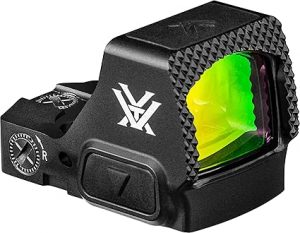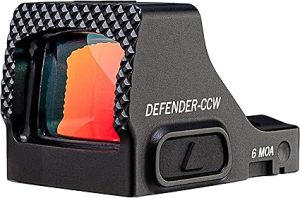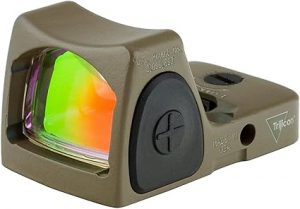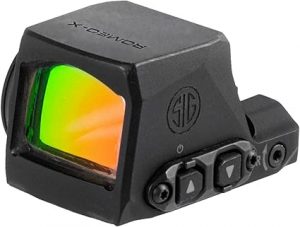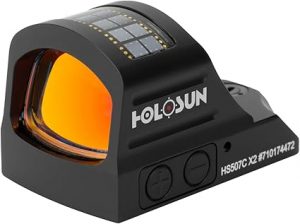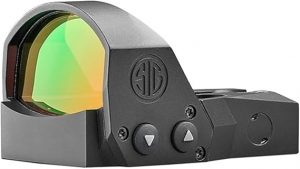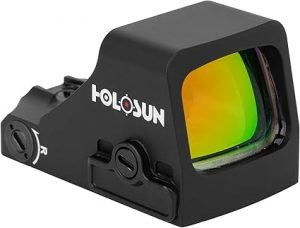Why Optics Are No Longer “Nice to Have”
Five years ago a micro-optic on a carry gun was brag material; in 2025 it’s creeping toward standard equipment. Faster first-shot accuracy, target and aiming point in one focal plane, and the option to shoot dusk-to-daylight without swapping sights have convinced everyone from USPSA champions to the local PD armorers. Brands such as Holosun, SIG Sauer, Vortex, Trijicon, and EOTech now field deep catalogs that span $200 range toys to $700 duty tanks.
Red Dot vs Green Dot — A Quick Eye-Science Detour
| Factor | Red Dot (~650 nm) | Green Dot (~540 nm) |
|---|---|---|
| Power draw | Lower (LED more efficient) | ~25-40 % higher drain |
| Battery life (typical 2032) | 40–100 k hrs | 20–50 k hrs |
| Contrast on grass/foliage | Fair | Better |
| Contrast on brick/dirt/snow | Better | Fair |
| Color-blind friendliness | Tough for red-weak shooters | Tough for green-weak shooters |
| Eye fatigue in low light | Slightly higher | Lower (eye picks green easiest) |
Why it matters: Roughly 8 % of men have red-green color deficiency. Red-weak shooters (deuteranomaly) often see a green emitter more crisply; green-weak shooters (protanomaly) experience the reverse. Always test both colors under daylight, indoor LED, and twilight before you swipe your card.
Emitter Style — Open Window or Enclosed Box?
| Style | Pros | Cons | Best For | Example Models |
|---|---|---|---|---|
| Open (exposed LED) | Light, wide field of view, cheapest | Rain, sweat, or pocket lint can kill the dot | Dry climates, hide-out carry, gamers | Vortex Defender CCW, Holosun 507K X2, Trijicon RMR HD |
| Enclosed (sealed window) | Weather-proof, easier to wipe, duty safe | Heavier, $100–150 more | Service pistols, farm mud, duck blinds | SIG ROMEO-X, Holosun 509T, EOTech EFLX |
If your gun lives in coastal humidity, a barn loft, or a duty holster, pay the weight penalty and go enclosed. If you’re an appendix-carry minimalist in Phoenix, an open LED is fine—just keep a tee-shirt corner handy.
Meet the Brands (and What They’re Really Known For)
| Brand | Flagship Micro Optic | Street $ (red) | Why People Buy It |
|---|---|---|---|
| Holosun | 509T X2 (enclosed Ti) | $430 | Solar-backup, Shake-Awake, multi-reticle, value king |
| SIG Sauer | ROMEO-X | $550 | U.S.-assembled, 20 k-hr battery, forged hood, side tray |
| Vortex | Defender CCW | $350 | Lifetime VIP warranty, big glass, budget-duty crossover |
| Trijicon | RMR HD | $650 | Bombproof pedigree, top-load battery, massive dot range |
| EOTech | EFLX | $390 | Holographic DNA, 20 k-hr 2032, crisp glass |
Feature Checklist — What Actually Matters
| Must-Check | Why It Matters |
|---|---|
| Footprint / Mount | RMR, K-cut, DeltaPoint, or ACRO? Buy the one matching your slide or factor the plate cost. |
| Battery Location | Top/side = no re-zero swaps. Bottom = remove optic to change coin cell. |
| Brightness Steps | 8 daylight & 2 NV is bare minimum; competition shooters love 12+. |
| Auto-modes | Solar or ambient sensors extend battery but can wash out under backlight—keep manual override. |
| Window Size | Big glass forgives sloppy presentation; tiny windows conceal easier. |
| Housing Material | 6061 Al is fine; 7075 or Ti survive ejection-port impacts. |
| Reticle Options | 2 MOA dot = precision; 32 MOA ring = shotgun/carbine; chevron (Primary Arms) = BDC holds. |
Choosing by Mission
Everyday Carry
-
Open emitter, sub-compact: Vortex Defender CCW red or Holosun 507K GR if foliage glare kills your red. Both sub-2 oz, side-load battery.
-
Enclosed micro: Holosun EPS Carry or SIG ROMEO-X Compact for sweat-proof operation.
Duty / Patrol
-
7075 or titanium enclosed optic mandatory. Think Trijicon RMR HD, SIG ROMEO-X Pro, Holosun 509T. All share side/top batteries and at least IP67 dust/water ratings.
Competition
-
Wider windows help on the move: Trijicon SRO, Holosun 507Comp, or EOTech EFLX (DeltaPoint footprint). Brightness must crank under stage lights.
Rural / Predator
-
Green dots pop against cedar and sage; battery life still matters. Vortex Defender XL Green or a Holosun 510C GR on a PCC gets you 50-yard shots with circle-dot speed.
Color-Blind Work-Arounds
If you’re not sure which cone cells are sleeping on the job:
-
Borrow a buddy’s optic in each color; test on a green hill and a red-brick wall.
-
Dim both to 50 %. If the dot blooms or fades, switch colors.
-
Remember: brightness > color. A dim red often beats a glaring green starburst.
-
Worst-case: pick up an optic with a multi-reticle ring; circle outlines stay visible even when the inner dot fuzzes.
When NOT to Run a Dot
-
Bank account low? Spend cash on ammo and fundamentals first.
-
Extreme mud/snow and no enclosed optic? Stick to tritium irons until you upgrade.
-
Pocket pistols without optic cuts (LCP, J-frame) — hammer-in rear sights still rule.
-
Agency policy — if internal SOP bans optics, practice irons now, lobby later.
Pros & Cons of Red-Dot Carry
✅ Pros
- Single focal plane = faster hits at mixed distances
- Aim small, miss small — 2 MOA dot shrinks groups
- Night-vision and low-light compatibility (proper brightness steps)
- Easier for aging eyes vs skinny iron front post
- Rapid target transitions once presentation is dialed
❌ Cons
- Upfront cost ($300-$700) plus slide cuts/plates
- Electronics can die (battery, water ingress) — back-up irons mandatory
- Bigger footprint can snag concealment garments
- Learning curve: dot-hunting slows new users
- Open emitters choke on mud, rain, pocket lint
Set-Up & Maintenance (No-BS Checklist)
-
Torque: 15–18 in-lb, blue Loctite, 24 h cure.
-
Witness marks: Paint pen the screws; movement = re-check.
-
Zero: 15 yd pistol / 50 yd PCC. Confirm at 5 yd and 25 yd.
-
Battery swap: Every birthday or daylight-savings change—CR2032 is cheaper than missing the shot.
-
Lens care: Plain water + microfiber; glass cleaner strips hydrophobic coatings.
Future Trends to Watch
-
On-board solar in more frames (SIG teases a Romeo Solar slide cut).
-
Thermal overlays: Holosun’s DRS-TH promised Q4 release blends 640 thermal layer with a daylight dot.
-
AI-assisted brightness: Trijicon RCR prototype uses dual sensors front/back to auto-balance dot against target glare.
-
Unified footprints: Word is Vortex and Primary Arms flirting with a common enclosed-mini spec to stop the plate chaos.
Final Shot — Pick the Dot That Fits You, Not the Forum War
-
Budget-minded conceal carry → Vortex Defender CCW red, $350.
-
Color-blind & foliage shooter → Holosun or Vortex green emitter; test before buying.
-
Duty grade → Trijicon RMR HD or SIG ROMEO-X Pro (forged hood, enclosed).
-
Competition speed → Trijicon SRO or Holosun 507Comp for window real estate.
-
Rain, mud, and Murphy → Any enclosed emitter; cleanliness beats marketing.
Master your draw and presentation first, then let the optic amplify skill—not mask slop. A dot is a force multiplier, not a magic wand. Train until the glass disappears and only the superimposed dot—and the job at hand—remain in focus.
💥 Where to Buy the Right Optic (Without Overpaying)
You don’t have to wander the web for hours or trust some sketchy site with a $15 discount and zero customer service. Every optic mentioned in this guide—Holosun, SIG Sauer, Vortex, Trijicon, and EOTech—can be found at:
👉 Amazon – Fast shipping, easy returns, and loads of verified reviews.
👉 VoodooFirearms.com – Trusted partner of Bark & Brass, run by real shooters, not just keyboard warriors. When buying optics from Voodoo they will mount and zero the optic for free.
Both carry legit inventory—none of that overseas knockoff garbage. So if something catches your eye (literally), you know where to click.
